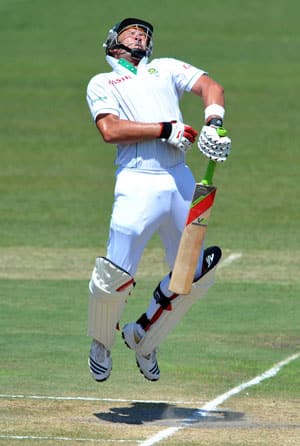India’s paucity in the fast lane
Paucity in the fast lane

The resultant delivery could be anything: a toe-crushing yorker that catches the batsman plumb in front or disturbing the furniture behind; a seaming/swinging delivery that grazes the edge of the bat or glove on way to the ‘keeper or fielder; an ugly bouncer that spits on pitching to intimidate the batsman into submission; or a snorter that forces the batsman sniff leather. And if any part of the batsman is left uncovered by protective gear, the damage is both physical and psychological. Of course, sometimes, a batsman wins this battle and uses the pace to his advantage and dispatches the ball to the ropes. But a genuine speedster always gets back with a more virulent delivery to avenge his temporary defeat. The ultimate insult to a batsman is when the stump caves in under the force of the attack and breaks into two pieces.
There is something macho about the tearaway speedsters who consistently make the batsmen scurry for cover with deliveries that threaten to literally polish off the opposition. And, since the fast bowlers begin the proceedings in any Test match, they can set the tempo for the match and like a warlord lead from the front. Cricket, in fact, is an insipid fare minus the arrogant swagger, cold stare, and belligerent attitude of a fast bowler.
There was a time, when the cricket landscape was dotted with quite a few vicious speed merchants, with a significant number of them hailing from West Indies, Australia, and England. In the ICC Player Rankings (as of June 2009), among the 34 top-rated fast bowlers (i.e., those who have secured minimum of 850 points), nine hail from Australia, eight from West Indies, seven from England, four from Pakistan, four from South Africa, one from New Zealand, and one from India (Kapil Dev, of course).
Rankings aside, India’s record in producing pacemen has been undistinguished, to say the least. During the early period in the cricketing history of India, pace bowlers were used as ‘ball-shine removers,’ for the spinners to take over. In fact, it can safely be said that pace bowling caught the fancy of the cricket fans of India only after the Kapil Dev stormed into the scene. While there bowlers in the past like Mohammed Nissar, Amar Singh, Ramakant Desai, Madan Lal, Karsan Ghavri, Roger Binny, Chetan Sharma, Manoj Prabhakar and Venkatesh Prasad, who prospered in patches, none could leave an indelible mark on the fast bowling scene like Kapil.
Also, India never managed to produce a potent new ball combination like Wes Hall and Charlie Griffith of West Indies, Thomson and Lillee of Australia, Imran Khan and Wasim Akram, and later Akram and Waqar Younis of Pakistan. Though Ghavri, Madan Lal, and Manoj Prabhakar supported Kapil now and then, the “Haryana Hurricane” often had to plough a lonely furrow.
Coming to the present, the pace bowling department of Indian cricket certainly boasts of more names now than in the past. There is Zaheer Khan who leads the pack, followed by S Sreesanth, Ishant Sharma, Praveen Kumar, Ashish Nehra, Ajit Agarkar, Irfan Pathan, L Balaji, Munaf Patel, RP Singh, Amit Bhandari, Aavishkar Salvi, VRV Singh, Abhimanyu Mithun, Sudeep Tyagi and Jaidev Unadkat. However, none of the young crop has been consistent enough to be regarded as a long-term prospect. Frequent injuries and patchy form are the other bugbears of the Indian pace bowling lot.
India, which has consistently produced batting greats and world class spinners, has miserably failed to produce incisive pace bowlers, something which the neighbouring Pakistan manages to do with unfailing regularity. The reasons ascribed for India’s failure to produce quality pace bowlers include the flat tracks preferred and prepared in India, the hot and humid conditions, and the physique and eating habits – largely vegetarian – of Indians. Commercialisation of cricket has also ensured that the rules governing the game are loaded in favour of the batsmen and pitches are tailor-made for batsmen to flourish. Also, shorter versions of the game like ODIs and T20s neither have a place nor offer much scope for genuine pace bowlers. A fast bowler thrives on experimentation, something that is not possible in these short versions of the game.
If India has to remain a top Test-playing nation, it has to focus on producing genuine quickies who can lead the attack from the front.
(Venkatesan Iyengar has published articles in various print and online publications on a host of topics, including, cricket, economics, business and finance. He has worked on projects for Carrefour, Asosiasi Asuransi Jiwa Indonesia and Thomson US. He lives in Hyderabad, India)